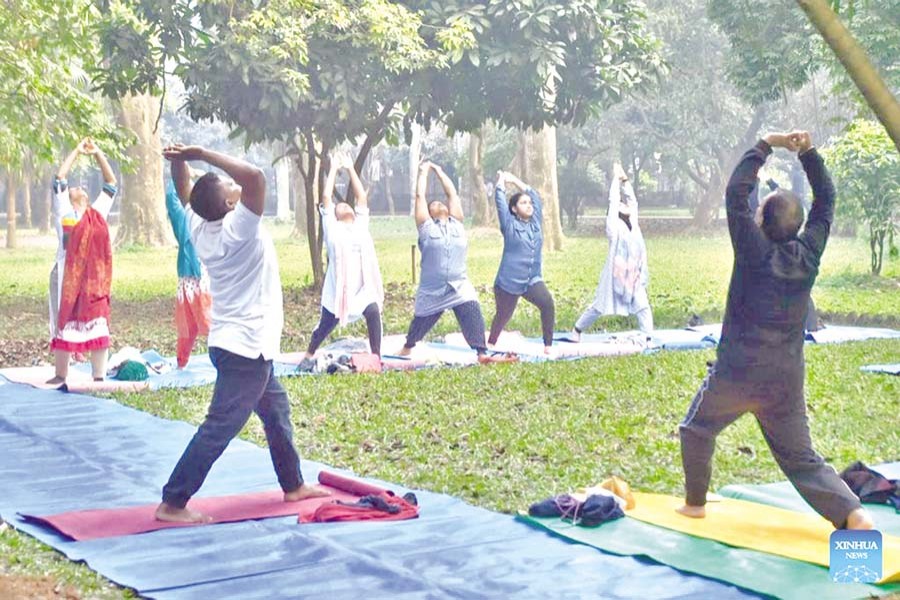
Health indices
Where do we stand?
Dr. Imtiaz Ahmed | Sunday, 7 April 2024

Every year, WHO celebrates 07 April worldwide as World Health Day. Each year, the theme focuses on the pressing health issue of the time. This year, the theme is ‘My health, my right.’ This theme highlights the struggle to implement universal access to healthcare as an inherent human right.
This year’s World Health Organization (WHO) theme highlights the gap between healthcare as a right and the reality of unequal access for many.
There are policies, guidance, and laws, but they are being as effective as expected for various reasons. WHO data shows that more than half of the global population still needs essential health care, which is critical to reaching the Sustainable Development Goal (SDG) goals.
As World Health Day is upon us, it may be an excellent time to review our country’s healthcare situation through the lens of ‘My health, my right’. How much headway did we make in transforming health care into a fundamental right for our people? Doing a comprehensive analysis, we can at least look at some indicators, namely access to care, safe water, and clean air.
Once this populous country was plagued with high maternal and infant mortality, widespread infectious diseases (e.g., TB, Leprosy) cutting our lives short and many more health scares.
With support from our international partners, child and maternal mortality decreased by two-thirds, lifespan increased to 72 years in 2017 compared to 65 in 2000, and access to contraception and other primary healthcare facilities improved.
Bangladesh also achieved food security regarding rice, vegetables, and fish. Malnutrition is now almost unheard of. This is due to massive agriculture and farming industry growth coupled with national development initiatives.
We have built a well-designed health infrastructure extending to the village levels. But does it make health care accessible to all? Unfortunately, not yet.
Access means infrastructure and the availability and affordability of services. Despite having health centres all across the country, the distribution of qualified healthcare workers is skewed towards urban areas. Only 25 per cent of those workers are in rural centres, but these are the areas where 70 per cent of our population lives.
It is easy to blame healthcare workers for not moving to rural areas. However, we need to create other facilities to incentivize people to move to remote areas. These include, but are not limited to, better transportation, communication, facilities for their families, work-life balance, and security.
We must also keep in mind that the number of qualified workers is also on the shorter side. There are many medical colleges now, and many doctors are coming out yearly. But it will take at least a decade to see visible changes.
Moreover, doctors are not the only healthcare workers. We need nurses and other support staff. Currently, there are 3.06 physicians for every 10000 people, while the ratio for nurses is 1.07:10000. So, we have more doctors than nurses.
But this should be the other way around. This is reflected in the resource distribution as well. Most of the health facilities are operating at below capacity. 35% of our health facilities have 25% vacancies, meaning they only have 75% of the approved staff.
The availability of advanced equipment and human resources is also an issue. People are often referred from the periphery to the big cities for better healthcare because the healthcare staff there do not have access to lifesaving instruments.
One example is ventilators and ICUs, which became evident during the COVID-19 pandemic. Similarly, specialists are rarely available in villages or remote areas.
The cost of health care is another barrier to achieving universal healthcare access. According to the World Bank (WB), only 2.63% of our GDP was allocated for health in 2023. As such, most of the healthcare expenses in our country are borne by the patients themselves. 2016-17 Bangladesh National Household and Expenditure Survey data revealed that out-of-pocket accounts for about 64% of health care expenses, and 62% is for consolation fees and medicine purchases. In terms of money, this amounts to almost 1.5 billion USD.
Even reasonable, well-off families can struggle with healthcare costs. Nearly 6 million people become poor yearly due to ever-increasing healthcare costs.
Many employers offer insurance, but it may need to be more comprehensive. The government needs to step in and start implementing an affordable scheme for the general population.
We can leverage our extensive mobile phone network to make specialist consultations nationwide easy. The Bangladesh Government has already established eHealth infrastructure at various levels. A draft guideline to impose eHealth standards is also pending approval from the cabinet.
Let us now examine the other types of access: access to safe water and clean air. Although clean water coverage has significantly expanded, around 40% of our population still lacks access to clean drinking water (WHO/UNICEF Joint Monitoring Programme Report, 2020).
Piped water is available to only 15% of people. Among the poor households with piped water, 86% show evidence of bacterial contamination. Arsenic contamination is still not completely eradicated, with 17% of the population suffering.
Dhaka is one of the top ten cities with the worst air quality. According to Abdoulaye Seck, World Bank Country Director for Bangladesh and Bhutan, “Air pollution creates a serious threat to public health and has major consequences on economic growth.’ Twenty per cent of premature deaths in Bangladesh are attributed to air pollution. Our government is committed to mitigating that, and in 2018, the Ministry of Environment introduced the National Action Plan for Reducing Short-Lived Climate Pollutants. The aim is to lower carbon emissions by 72% by 2040.
Bangladesh is on the right track to achieving the SDGs, as it is ahead of its neighbours in many health indices. But that should not make us complacent. We still have a long way to go. Only then can our people proudly proclaim, ‘my health, my right.’
imtiazdmc@gmail.com